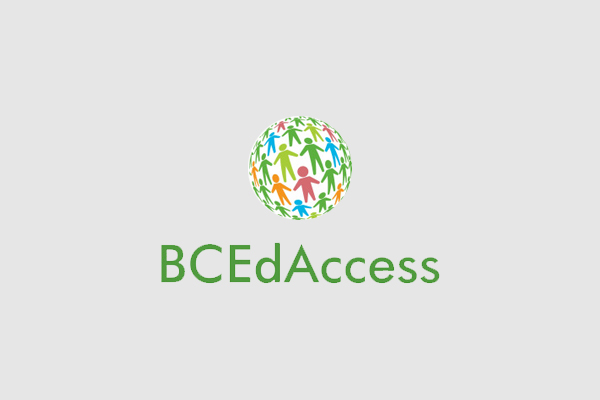This week we had guest speakers, Tracy Humphreys and Kaori Lau, from BCEdAccess, educate our class on the power of technology in aiding students with disabilities (physical or intellectual etc) and differing abilities. BCEdAccess Society, a recognized charitable organization, is dedicated to supporting families of students with disabilities and complex learners throughout British Columbia. Their parent peer support group boasts a membership of over 5000 community members, offering information and assistance to individual families, educators, and organizations. They focus on promoting the human right to equitable access to education and advocate to the government for systemic change.
BCEdAccess more broadly describes their work in two ways:
“1. Through our peer support group and our presentations, workshops, resources and referrals, we try to ensure that children and youth in K-12 education who are struggling right now with equitable access to education, and their families who may be in crisis, are supported with the right tools and resources to fix things as soon as possible. We help them to navigate the K-12 education system and beyond, as it is right now, and find a path to a solution.”
“2. We advocate at the systemic level to bring much needed positive change to education and other systems for children and youth with disabilities and their families. The tagline you’ll read on our website is ‘Collective Action for Equitable Access to Education’. In recent years we have also engaged in conversations and action around other child-serving government Ministries, recognizing that all these systems have the child at the centre and that there are overlapping agreements between them and the Ministry of Education and Child Care in British Columbia.”
As a class, we brainstormed some ways in which technology can support our students that need it! Here are some ideas we came up with:
- Text-to-Speech and Speech-to-Text Tools: These tools help students with reading difficulties by converting text into spoken words or vice versa.
- E-books and Audiobooks: Digital books with audio features make reading more accessible for students with visual impairments or learning disabilities.
- Adaptive Keyboards and Mice: Customizable keyboards and mice cater to various physical needs, allowing students with motor difficulties to interact with devices more comfortably.
- Voice Recognition Software: Enables students with limited motor skills to control computers and create content using voice commands.
- Adaptive Learning Systems: Platforms that adjust the difficulty level of content based on a student’s performance, ensuring that learning is tailored to individual needs.
- Digital Learning Apps: Interactive apps can provide additional support for students with intellectual disabilities, offering engaging and adaptive activities.
- Augmentative and Alternative Communication (AAC) Devices: Assist students with communication disorders by providing tools for expressive and receptive communication.
- Social Skills Apps: Apps designed to help students with social difficulties learn and practice social interactions.
Additionally, we discussed ableism in the classroom.
Ableism is a form of discrimination or prejudice against individuals with disabilities, often resulting from societal attitudes that devalue and marginalize people based on their physical, cognitive, or sensory abilities. It involves both overt and subtle biases, leading to unequal treatment, exclusion, and systemic barriers for individuals with disabilities. Ableism can manifest in various ways in classrooms, impacting both students and educators. Here are some examples of how ableism can be observed in educational settings:
- Inaccessible Physical Environments:
- Example: Lack of ramps, elevators, or accessible restrooms can make it difficult for students with mobility impairments to navigate the school environment.
- Limited Accommodations and Support Services:
- Example: Failure to provide necessary accommodations, such as assistive technology, accessible materials, or additional time for exams, can disadvantage students with disabilities.
- Stereotyping and Stigmatization:
- Example: Teachers or peers may hold stereotypes about certain disabilities, assuming, for instance, that a student with ADHD is simply not trying hard enough or that a student with autism lacks social skills.
- Inclusive Curriculum Gaps:
- Example: A curriculum that lacks representation of diverse abilities or fails to address the contributions of individuals with disabilities reinforces ableist perspectives, contributing to the erasure of their experiences.
- Bullying and Social Exclusion:
- Example: Students with disabilities may face bullying or social exclusion based on their differences, perpetuating harmful stereotypes and creating an unwelcoming environment.
- Lack of Teacher Training:
- Example: Teachers who are not adequately trained to work with students with disabilities may inadvertently create an environment that is not inclusive, with limited understanding of diverse learning needs.
- Microaggressions:
- Example: Teachers or students may unknowingly engage in microaggressions, such as using derogatory language or making insensitive comments about a student’s disability, reinforcing harmful stereotypes.
- Unequal Access to Extracurricular Activities:
- Example: Students with disabilities may face barriers to participating in extracurricular activities due to a lack of accommodations or inclusive practices.
Another all too common form of ableism in the classroom resides in the fact that not all disabilities can be physically seen. As teachers, we need to ensure that all students get the resources necessary to support learning and growth!
